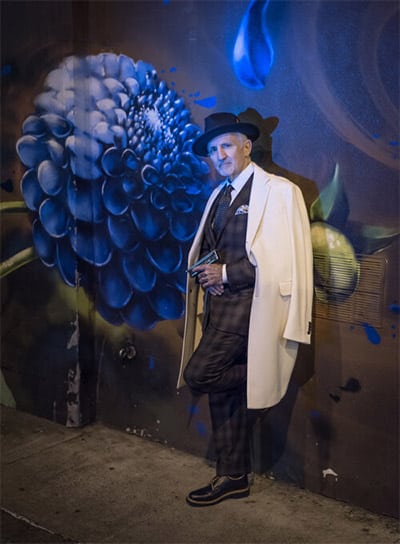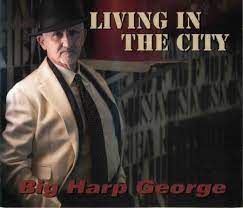
The most educated man in the blues takes an analytical approach to his music.
“Big Harp George” Bisharat, 66, has figured out that songwriting is the most important thing that he does. “The songs are not platforms for my harmonica prowess,“ he said. “They’re songs. Let the song dictate what it needs.”
Therefore, his unique style on the chromatic harmonica isn’t featured every one of the 13 original songs on his latest album, “Living in the City.” Released in October 2020, the album features an all-star cast of players, including “the Aretha Franklin of Palestine” Amal Murkus and the late acclaimed guitarist Little Charlie Baty. It was recorded in San Jose at Kid Andersen’s Greaseland Studios and produced by Chris Burns, who has been Big Harp George’s writing partner on all four of his albums.
A graduate of the University of California, Berkeley, Bisharat earned a master’s degree in Modern Middle East History at Georgetown, and earned both a Ph.D in anthropology and a law degree at Harvard. After working as a public defender for the city of San Francisco, he has taught at UC Hastings Law for 30 years. He tried to retire, but the school needs him to teach a criminal practice clinic for second and third year students, which he does via Zoom.
For purposes of this story, Bisharat won’t be referred to as Dr. or Professor. It will be Big Harp George, who was already an accomplished musician when he arrived in Washington, D.C. to attend Georgetown. At nightclubs including Childe Harold, he saw harmonica players such as Pierre Beauregard with Tom Principato’s band Powerhouse and Charlie Sayles, who often busked on sidewalks. Out-of-towners included Chicago’s Carey Bell and Texas’ Kim Wilson with the Fabulous Thunderbirds.
“Those were inspiring days,” said Big Harp George, who “grew up on Chicago blues” but writes his blues songs mostly with a West Coast jump style.
Because he spent summers studying in Cairo, Egypt, Big Harp George wasn’t able to make full-time band commitments. After his education, he moved back to Northern California for good in the 1980s but did not expect to add recording artist to his list of personal achievements.
“I didn’t see any point in recording because I didn’t think I was doing anything special,” he said. “I was just another decent diatonic player with nothing particularly new to add to the blues conversation. But once I started developing some facility on the chromatic, that changed.”
The metamorphosis began after one of Mark Hummel’s Harmonic Blowouts in 2012.
“I had a 16-hole chromatic harmonica tuned to C; most blues player with that big harp would play in third position,” Big Harp George said.
Little Charlie, who played with harp virtuoso Rick Estrin for decades, was intrigued and he encouraged Big Harp George.
The tune that caught his attention was “Chromaticism,” and it wound up being the title song to Big Harp George’s recording debut in 2014. He was nominated for a Blues Music Award for Best New Artist.
“It was fresh and fun to my ear, but I didn’t know how the blues world would react,” he said. “A fellow musician said, ‘That sounds like “Sesame Street” on crack.’ It wasn’t a compliment, but I still thought it was pretty funny. And when Little Charlie, a musician of that stature, says it’s cool, I’ll keep doing it.”
The first songs Big Harp George wrote were simple 12-bar blues, but now his writing has evolved into elaborate scores. He has a penchant for adding elements. How does he know when a song is completed?
“That’s kind of my specialty,” said Chris Burns, the producer of the latest album. “I know a million people who can get started on a project and they can never finish.”
Burns has backed Bay Area blues and R&B singers for four decades, including 28 years with Maria Muldaur. He said he began to work with Big Harp George because he has a great voice.
“I help him with his songwriting,” Burns said. “He comes with an idea and I help him organize it.”

Burns knows a lot of people in the industry and Kid Andersen probably knows even more. That’s how so many talented musicians came together. They include Carlos Reyes, a Paraguayan harpist and violin player, D’Mar, who was Little Richard’s longtime drummer, the renowned gospel trio of brothers, Sons of the Soul Revivers, and numerous horn players inkling trombonist Mike Rinta and saxophonist Michael Peloquin.
Big Harp George provides the secret weapon to the sessions: His homemade French stews. He said it is to show his gratitude and respect.
“I always hire people who can really lay it down and I like making them happy,” he said. “I think happy musicians play well. They give it up for you when it’s their turn.”
“You have to have a solid foundation to start with,” Burns said. “To me, that’s getting the rhythm section right and then the horns will fall in the right place. It’s like lanes. You’re on the freeway. Get in your lane and stay in your lane. First you have to define your lanes.
“And when you have an engineer with good ears, it makes it real easy. I rarely have a disagreement with (Andersen). It saves a lot of time. He’s really good at editing things and polishing things up.”
After opening with three witty and swinging blues, “Living in the City” changes directions, all the way to Brazil for “Heading Out to Itaipu,” presented with horns charted by Mike Rinta, Ben Torres on flute and Carlos Reyes playing violin and Paraguayan harp.
“We’re taking folk melodies and expanding on them,” Burns said. “I think it’s brilliant. It’s not blues, but it sure is nice.”
“Bayside Bounce,” is a swinging surprise in which the big harp takes the lead on a Count Basie-flavored instrumental.
Sons of the Soul Revivers – James, Dwayne and Walter Morgan – sing backup on six if the 13 songs, including “Enrique,” a powerful story about an immigrant’s struggle to survive and elude capture. Lisa Leuschner Andersen heightens the emotion with her vocals.
The best comes last with a “tribute to young Gaza Palestinians demonstrating for freedom and dignity.” That country’s singing superstar, Amal Murkus is featured along with her son, Firas Zreik, on zither.
“I get excited by hearing new approaches and innovation. That and variety,” Big Harp George said. He backs it up with this superb album.
-Tim Parsons
Big Harp George
‘Living In The City’
Release: October 10, 2020
Label: Blues Mountain Records
Favorite tracks: ‘Meet Me at the Fence,’ ‘Heading Out to Itaipu’
Musicians
Big Harp George – vocals and harmonicas
Amal Murkus – vocals
Ben Torres – baritone sax and flute
Carlos Reyes – Paraguayan harp and violin
Chris Burns – keyboards and vocals
D’Mar – percussion
Doug Rowan – baritone sax
Firas Zreik – qanun (zither)
June Core – drums
Joe Kyle – basses
Kid Andersen – basses, guitar, and vocals
Lisa Leuschner Andersen – vocals
Little Charlie Baty – guitar
Loay Dahbour – iiqae (Arabic percussion)
Loralee Christensen – vocals
Michael Peloquin – saxes
Mike Rinta – trombone
Sons of the Soul Revivers (James, Dwayne, and Walter Morgan) – vocals
